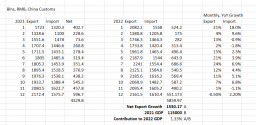I agree completely. My previous estimate was that new housing construction in China needs to roughly halve in size.
But look at what I actually wrote. A notional 20% of excess savings (6 Trillion RMB) spent on new housing and
renovations, which is the key element.
There are still a lot of apartments left as empty concrete shells, because then they can still be sold as new apartments rather than lower-value 2nd hand apartments. I disagree with this way of thinking, but it's what the market believes.
But if expectations of future housing price appreciation are muted/stable, then much of this existing stock will come to market, whether it is sold to an owner-occupier or furnished so that it can be rented out.
So what I am saying is that housing and housing renovations will see some sort of recovery in 2023 compared to 2021/2022
Yes, people saved last year because they were afraid. You can see it in the consumer confidence numbers below.
But now the dominant media narrative is that COVID is/will be defeated.
And it looks like they've already reached herd immunity in the cities.
So there has been a political decision to declare complete victory over COVID and increase consumer confidence in the population and therefore income expectations.
Currently consumer confidence is still muted because of COVID, but after Chinese New Year, it's going to explode upwards and return back to normal levels
That initial boost in spending (from consumers and presumably the government) will drive a virtuous cycle in terms of business investment, more consumer spending, government receipts, stock market valuations etc etc
The solar polysilicon investment numbers would actually be:
2022: Base Year
2023: 2 Trillion RMB additional investment required (1 million tonnes extra annual capacity if fully-utilised)
2024: 4 Trillion RMB additional investment required (2 million tonnes extra annual capacity if fully-utilised)
2025: 6 Trillion RMB additional investment required (3 million tonnes extra annual capacity if fully-utilised)
Again, the caveat is that this will be split between China and overseas.
Plus someone has to come up with the large upfront investment in exchange for low-cost electricity for the next 30 years.
The impact of imported materials/energy to manufacture polysilicon is overstated.
The raw material for polysilicon is literally sand and the energy requirement is electricity, which is generated from domestic Chinese sources.

